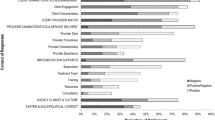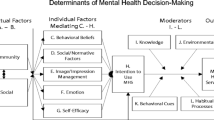Abstract
This study of 33 mental health therapists and 30 case managers examined the relationship between practitioners' assessments of the importance of potential treatment barriers and their use of engagement strategies to overcome those barriers and improve treatment participation. Results confirmed the hypothesis that workers who viewed treatment barriers as more important were significantly more active in their reported efforts to engage clients (r = .28, p < .05). Although no significant differences between the two groups were found in overall use of engagement strategies, we found a significant interaction effect between position and types of strategies used, with therapists employing more discussion strategies while case managers were more likely to employ practical engagement strategies (F = 35.79, p < .001). Findings suggest the desirability of enhancing mental health workers' sensitivity to the range of barriers that clients may experience, and expanding the repertoire of engagement strategies they use to encourage client retention.
Similar content being viewed by others
REFERENCES
Acosta, F. X. (1980). Self-described reasons for premature termination of psychotherapy by Mexican American, black American, and Anglo-American patients. Psychological Reports, 47, 435–443.
Armbruster, P. & Fallon, T. (1994). Clinical, sociodemographic, and systems risk factors for attrition in a children's mental health clinic. American Journal of Orthopsychiatry, 64(4), 577–585.
Bachrach, L. L. (1989). Case management: Toward a shared definition. Hospital and Community Psychiatry, 40(9), 883–884.
Bachrach, L. L. (1992). Case Management Revisited. Hospital and Community Psychiatry, 43(3), 209–210.
Baekeland, F. & Lundwall, L. (1975). Dropping out of treatment: A critical review. Psychological Bulletin, 82(5), 738–783.
Carpenter, P. J., Morrow, G. R., DelGaudio, A. C., & Ritzler, B. A. (1981). Who keeps the first outpatient appointment? American Journal of Psychiatry, 138(1), 102–105.
Eiduson, B. I. (1968). Retreat from help. American Journal of Orthopsychiatry, 38, 910–921.
Farley, O.W., Peterson, K.D., & Spanos, G. (1975). Self-termination from a child guidance center. Community Mental Health Journal, 11(3), 325–334.
Kazdin, A. E., Holland, L., Crowley, M., & Breton, S. (1997). Barriers to treatment participation scale: Evaluation and validation in the context of child outpatient treatment. Journal of Child Psychology and Psychiatry, 38(8), 1051–1062.
Kazdin, A. E., Mazurick, J. L. & Siegel, T. C. (1993). Treatment outcome among children with externalizing disorder who terminate prematurely versus those who complete psychotherapy. Journal of the American Academy of Child and Adolescent Psychiatry, 33, 549–557.
Kournay, R.F.C., Garber, J., & Tornusciolo, G. (1990) Improving first appointment attendance rates in child psychiatry outpatient clinics. Journal of the American Academy of Child and Adolescent Psychiatry, (4), 657–660.
McKay, M.M., Bennett, E., Stone, S., & Gonzales, J. (1995). A comprehensive training model for inner-city social workers. Arete, 20(1), 56–64.
McKay, M. M., McCadam, K., & Gonzales, J. J. (1996). Addressing the barriers to mental health services for inner city children and their caretakers. Community Mental Health Journal, 32(4), 353–361.
McKay, M.M., Nudelman, R., McCadam, K., & Gonzales, J. (1996). Evaluating a social work engagement approach to involving inner-city children and their families in mental health care. Research on Social Work Practice, 6(4), 462–472.
McKay, M.M., Stoewe, J., Mc Cadam, K., & Gonzales, J. (1998). Increasing access to child mental health services for urban children and their caregivers. Health and Social Work, 23(1), 9–15.
Noonan, J. R. (1973). A follow-up of pre-therapy dropouts. Journal of Community Psychology, 1, 43–44.
Rogawski, A. S. & Edmundson, B. (1971). Factors affecting the outcome of psychiatric interagency referral. American Journal of Orthopsychiatry, 127, 925–934.
Russell, M. N., Lang, M., & Brett, B. (1987). Reducing dropout rates through improved intake procedures. Social Casework, 421–425.
Shivack, I. M. and Sullivan, C. W. (1989). Use of telephone prompts at an inner-city outpatient clinic. Hospital and Community Psychiatry, 40(8), 851–853.
Singh, H., Janes, C.L., & Schechtman, J.M. (1982). Problem children's treatment attrition and parents' perception of the diagnostic evaluation. Journal of Psychiatric Treatment Evaluation, 4, 257–263.
Solomon, P. (1998). The conceptual and empirical base of case management for adults with severe mental illness. In J. B. W. Williams & K. Ell, Advances in Mental Health Research: Implications for practice (pp. 482–497). Washington, D.C.: NASW Press.
Szapocznik, J., Perez-Vidal, A., Brickman, A. L., Foote, F. H., Santisteban, D., Hervis, O., & Kurtines, W. M. (1988). Engaging adolescent drug abusers and their families in treatment: A strategic structural systems approach. Journal of Consulting and Clinical Psychology, 56(4), 552–557.
Wierzbicki, M. & Pekarik, G. (1993). A meta-analysis of psychotherapy dropout. Professional Psychology Research and Practice, 24(2), 190–195.
Author information
Authors and Affiliations
Rights and permissions
About this article
Cite this article
Manfred-Gilham, J.J., Sales, E. & Koeske, G. Therapist and Case Manager Perceptions of Client Barriers to Treatment Participation and Use of Engagement Strategies. Community Ment Health J 38, 213–221 (2002). https://doi.org/10.1023/A:1015263606948
Issue Date:
DOI: https://doi.org/10.1023/A:1015263606948




